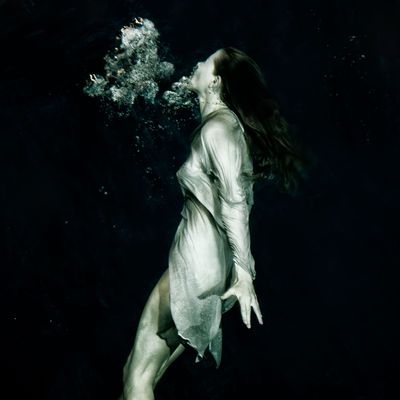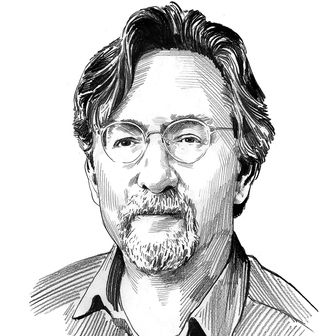
When the soprano Barbara Hannigan stepped into the wood-paneled Board of Officers room at the Park Avenue Armory and took up her position beneath the portraits of military men, she unwittingly matched their pose: shoulders back, right palm on the piano, left hand hip-height on the pommel of an imaginary sword. But while the painted soldiers gloried in their stiffness, the music that shuddered through Hannigan’s body fought for control of her limbs. That unmoored left hand kept floating toward the ceiling and her shoulders twitched as if she were suppressing the urge to dance — or conduct. She is one of the most physical singers on the opera stage; stillness does not come naturally to her. Confined by the clubby Victorian chamber and powered by the steamy music of Jugendstil Vienna, she seemed ready to burst into fiery, focused motion. Instead, her voice did.
Hannigan is one of those rare performers whose presence fuses so completely with the music that, while she’s onstage, hers seems the only possible interpretation. At the Armory, she sang a program of songs by Schönberg, Webern, Berg, Zemlinsky, Alma Mahler, and Hugo Wolf, composers who channeled their period’s decadence into orchid-scented music. They set poetry of gloaming, of unnamable yearnings, of moonlight-streaked cities brooding in the vale — and Hannigan had a timbre for every tint. These songs can sometimes be precious and brittle, but she sang them fearlessly, like a succession of two-minute operas. Zemlinsky’s “Schlaf nur ein” sharpened into the angriest lullaby you ever heard, full of dreams, guilt, ghosts, and thrilling rebuke. Hannigan’s voice — light and agile but with reserves of darkness — dispenses intensity in minute gradations. Reinbert De Leeuw pulled violet harmonies and liquid rhythms out of the piano (though he looked as delighted to be there as if he were waiting his turn at an unemployment office).
The program was De Leeuw’s idea, and their partnership is total. I spoke to Hannigan a few days before the concert, and she told me that they had recently recorded the program in a studio, where she could move with a freedom that would be distracting on the concert stage. De Leeuw thanked her for conducting him, the kind of remark that can sound sarcastic but wasn’t. “I wasn’t conducting,” she protested. “Yeah, you were,” he said.
If, at the Armory, Hannigan seemed like she was raring for action, it’s because the recital is too restrictive a genre to contain her talents. Only a few sopranos in the world can manage the vocal aerialism of György Ligeti’s Mysteries of the Macabre, a set of orchestral songs that slam together stage whispers, whistle-range high notes, canyon’s-breadth leaps, and impish wit. Fewer still could carry the piece off while dressed in a slightly disturbing sexy-schoolgirl costume, as she once did. But only Hannigan could sing it (in a patent leather dominatrix outfit and black bob) and conduct the orchestra at the same time. Hannigan’s 2013 performance with the Gothenburg Symphony Orchestra is the kind of miracle that YouTube was made to preserve — especially since she has since retired the piece from her repertoire. “I’d gone as far as I wanted to and as far as I could,” she says. “When you have that on a concert with other music, it’s hard for the audience to remember anything else. It usurps the power of everything else on the program. So I chose not to sing it anymore, because I didn’t want it to be perceived as a novelty act.”
She needn’t have worried. Hannigan opens her new recording, Crazy Girl Crazy, with Luciano Berio’s Sequenza III, a 1965 tour de force of nimble humor for unaccompanied voice, and follows it with a gripping version of Berg’s Lulu suite, which she both sings and conducts. Pianists or violinists regularly conduct while they play, but for singers, the combination is rare, especially in the hyperrefined, rhythmically complex repertoire she favors. Singing one phrase while cuing the next means that she has to be simultaneously with the orchestra and ahead of it. “It’s like splitting the brain,” Hannigan says. “I’m in two time zones, a split second apart.”
The feat, difficult as it is, makes artistic sense. Doing both removes the guesswork and approximation. “I can be in tune with my own rhythm. No matter how amazing the man on my left is, he cannot understand my body in that way.” Even within the strictures of her recital at the Armory, it was clear that she must bring to the podium an innate sense of how to charge a score with drama, and how to translate sound into motion. Even when she conducts non-vocal music, “the most important thing that I can show the orchestra is how I breathe. If I’m singing the music inside my body, then I will land those gestures in a very organic way.”
Just as breathing helps her move and moving helps her sing, merging roles has given Hannigan new insight into the psychological dynamics of the rehearsal process. “Singers don’t always understand all the things a conductor has to take care of. When you make music, it’s really intimate and you see something about other human beings that you may not see in any other situation. Everyone is vulnerable and emotions are high, so there’s the possibility for ecstatic moments but also for getting hurt. Sometimes musicians get upset if they think the conductor gets mad at them. But it’s not personal. We all have to surrender to the score.”
Most conductors who achieve mastery and prominence do so only after years of simmering in freelance gigs, assistantships, and jobs with regional ensembles and backwater opera companies. For women, the slog has often been longer and lonelier, though that has begun to change. The slowness suits Hannigan fine, since, now in her mid-40s, she’s planning ahead to a second career. “We singers have a ‘best before’ date stamped on our foreheads. I have another good ten years, but at that point I don’t want to stop making music.” Next year, she conducts her first full opera, a semi-staged version of Stravinsky’s The Rake’s Progress, and it’s easy to imagine a performer of such technical sophistication, onstage experience, and natural theatricality becoming a major presence in opera house pits.
It says something about the limitations of New York that she has no natural home here. She has appeared in some of the most memorable musical events of the last decade (Ligeti’s opera Le Grand Macabre, with the New York Philharmonic; Hans Abrahamsen’s Let Me Tell You, with the Cleveland Orchestra at Carnegie Hall; and George Benjamin’s opera Written on Skin, at Mostly Mozart). But she has never sung at the Met, and New Yorkers should be getting more regular and varied doses of such an extraordinary performer in her prime. I have a fantasy: that the Met will one day commission an operatic version of Margaret Atwood’s Alias Grace and get it to the stage in time for Hannigan to sing the title role. If not, she can always conduct the premiere.
Hannigan will perform at the Park Avenue Armory on November 18.


